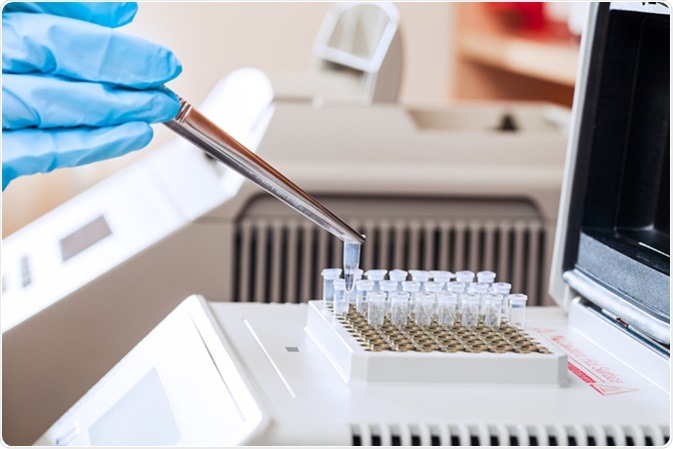Amplifying Specific Fragments of DNA
Polymerase Chain Reaction (PCR) is a method which utilizes the mechanism of DNA replication to amplify a specific part of DNA. This involves the use of DNA polymerase, which makes new strands of DNA using free nucleotides.

Technician loading test tubes with sampled DNA for polymerase chain reaction. Image Credit: Nikita G. Sidorov / Shutterstock
By using two short fragments of DNA, known as primers, it is possible to direct the DNA polymerase to specific regions of the DNA. In a standard PCR reaction, there are cycles of reactions which exponentially amplify the target DNA.
Introduction to PCR
How do you Quantify the Amount of Target DNA?
In real-time, or quantitative, PCR (qPCR), a fluorescent dye is used to detect the amplification as it happens in real-time. At low levels, the fluorescence signal is not detectable above the background noise. As the levels increase, so does the fluorescence signal. The number of cycles it takes for the fluorescence signal to become detectable is known as the “Ct value”. Ct values are expressed as cycles numbers, i.e. if it takes 15 cycles for the signal to become detected, then the Ct value is 15. Higher amount of DNA means that it takes less time for the fluorescence signal to build above the background noise, which in turn means that it takes fewer cycles. Therefore, higher DNA concentrations have a lower Ct value.
If known concentrations of DNA are used alongside test samples, then the amount of DNA in the test samples can be quantified. This is possible because of the relationship between the Ct value and the amount of target DNA; a difference by one Ct value (cycle) corresponds to a two-fold difference in the amount of DNA. Therefore, if a known amount of DNA had a Ct value of 15, and the test sample had a Ct value of 14, then the test sample has twice the amount of DNA.
3) Polymerase Chain Reaction (PCR) - Quantitative PCR (qPCR)
Different Fluorescent Dyes
There are different types of fluorescent dyes that can be used in qPCR; specific and non-specific dyes. Non-specific dyes, such as SYBR Green, bind non-specifically to double-stranded DNA. As the amount of PCR product increases, this creates more double-stranded DNA for the SYBR Green to bind to. This in turn means that there is a stronger fluorescent signal. However, the problem is that it can bind to any double-stranded DNA, such as the primers, not just the target section being amplified.
Specific dyes are incorporated into probes, such as the TaqMan probe. The TaqMan probe is a specific sequence of DNA which acts as the primer for the DNA polymerase. To the DNA fragment, a fluorescent dye and a quencher is added; due to the close proximity of the quencher to the fluorescent dye, the dye does not emit a fluorescent signal. When DNA polymerase extends from the probe, the quencher is cut-off from the probe and this leads to the emission of fluorescence from the dye. Because of the specific nature of the probe, the only fluorescence emitted will be the amplified target sequence.
How is qPCR Used in Industry?
In the food industry qPCR can be used to detect pathogens and the presence of genetically modified organisms (GMOs). This ensures that the food is not contaminated by pathogens, and that the consumers are fully informed of what they are about to consume.
Traditional methods for detecting food pathogens rely on culturing methods, which are very time consuming. Using qPCR is a much faster and can be more selective, particularly if a probe like TaqMan is used.
Additionally, qPCR can be used in research. For example, a study by Malorny et al used a TaqMan based approach to see if Salmonella bacteria could be detected, for research into food poisoning. Salmonella is a bacterium which can be found in the guts of humans and animals, causing food poisoning if contaminated meat, eggs or dairy products are consumed. Within the study, the authors tested the likelihood of detecting Salmonella from food samples, such as meat and raw milk; they found that their qPCR was very accurate.
While qPCR is a good alternative to culturing, there are drawbacks to using qPCR; for example, the reagents used in qPCR are expensive, and it is a much more technically demanding approach compared to culturing. Also, currently there are no standardized methods, therefore it would be difficult to implement the use of qPCR as a food safety protocol.
Further Reading
Last Updated: Aug 23, 2018